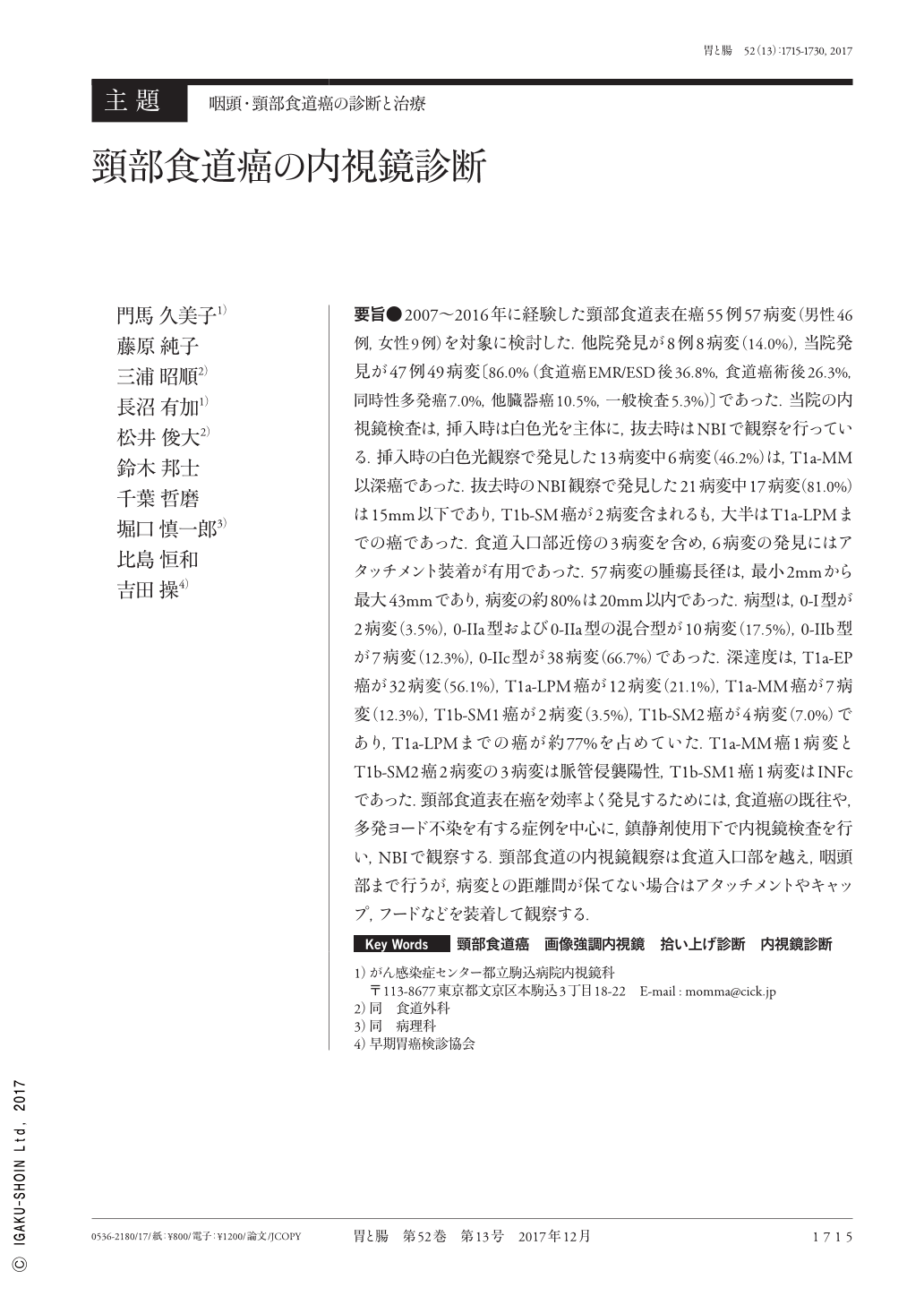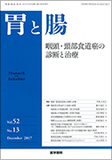Japanese
English
- 有料閲覧
- Abstract 文献概要
- 1ページ目 Look Inside
- 参考文献 Reference
要旨●2007〜2016年に経験した頸部食道表在癌55例57病変(男性46例,女性9例)を対象に検討した.他院発見が8例8病変(14.0%),当院発見が47例49病変〔86.0%(食道癌EMR/ESD後36.8%,食道癌術後26.3%,同時性多発癌7.0%,他臓器癌10.5%,一般検査5.3%)〕であった.当院の内視鏡検査は,挿入時は白色光を主体に,抜去時はNBIで観察を行っている.挿入時の白色光観察で発見した13病変中6病変(46.2%)は,T1a-MM以深癌であった.抜去時のNBI観察で発見した21病変中17病変(81.0%)は15mm以下であり,T1b-SM癌が2病変含まれるも,大半はT1a-LPMまでの癌であった.食道入口部近傍の3病変を含め,6病変の発見にはアタッチメント装着が有用であった.57病変の腫瘍長径は,最小2mmから最大43mmであり,病変の約80%は20mm以内であった.病型は,0-I型が2病変(3.5%),0-IIa型および0-IIa型の混合型が10病変(17.5%),0-IIb型が7病変(12.3%),0-IIc型が38病変(66.7%)であった.深達度は,T1a-EP癌が32病変(56.1%),T1a-LPM癌が12病変(21.1%),T1a-MM癌が7病変(12.3%),T1b-SM1癌が2病変(3.5%),T1b-SM2癌が4病変(7.0%)であり,T1a-LPMまでの癌が約77%を占めていた.T1a-MM癌1病変とT1b-SM2癌2病変の3病変は脈管侵襲陽性,T1b-SM1癌1病変はINFcであった.頸部食道表在癌を効率よく発見するためには,食道癌の既往や,多発ヨード不染を有する症例を中心に,鎮静剤使用下で内視鏡検査を行い,NBIで観察する.頸部食道の内視鏡観察は食道入口部を越え,咽頭部まで行うが,病変との距離間が保てない場合はアタッチメントやキャップ,フードなどを装着して観察する.
We investigated 55 patients(46 males and 9 females)with 57 lesions of superficial cancer of the cervical esophagus between 2007 and 2016. Lesions of eight patients(14.0%)were detected at other hospitals, and 49 lesions in 47 patients(86.0%)were detected at our hospital(after endoscopic treatment of esophageal cancer, 36.8% ; after surgery of esophageal cancer, 26.3% ; synchronous cancer, 7.0% ; cancers of multiple organs, 10.5% ; and general examination, 5.3%). At our hospital, primary observation was conducted via endoscopic examination using white light during the insertion phase and NBI during the withdrawal phase. In this study, 6 of 13 lesions(46.2%)detected with white light during the insertion phase were T1a-MM or deeper cancer. Meanwhile, 17 of 21 lesions(81.0%)detected with NBI during the withdrawal phase were <15mm in size, and a majority of them invaded up to T1a-LPM. However, they included two lesions of T1b-SM cancer. Attachments were useful for detecting six lesions, including three lesions near the esophageal inlet.
The long diameters of 57 lesions ranged from 2 to 43mm, and 80% of these lesions were within 20mm in size. The disease type included type 0-I in 2 lesions(3.5%), type 0-IIa and mixed-type 0-IIa in 10 lesions(17.5%), type 0-IIb in 7 lesions(12.3%), and type 0-IIc in 38 lesions(66.7%). The depth of invasion included T1a-EP cancer in 32 lesions(56.1%), T1a-LPM cancer in 12 lesions(21.1%), T1a-MM cancer in 7 lesions(12.3%), T1b-SM1 cancer in 2 lesions(3.5%), and T1b-SM2 cancer in 4 lesions(7.0%). Thus 77% of lesions invaded up to T1a-LPM. Three lesions, including one lesion of T1a-MM cancer and two lesions of T1b-SM2, were positive for vascular invasion, and one lesion of T1b-SM1 cancer was INFc.
The efficient detection of superficial cancer of the cervical esophagus can be achieved by observation with NBI endoscopic examination using sedatives, primarily in patients with a history of esophageal cancer and multiple iodine-unstained lesions. In endoscopic observation of the cervical esophagus, the endoscope reaches the pharyngeal region, going through the esophageal inlet. When a sense of distance to lesions cannot be gauged, observation should be performed with the endoscope equipped with attachments, caps, hoods, etc.

Copyright © 2017, Igaku-Shoin Ltd. All rights reserved.


